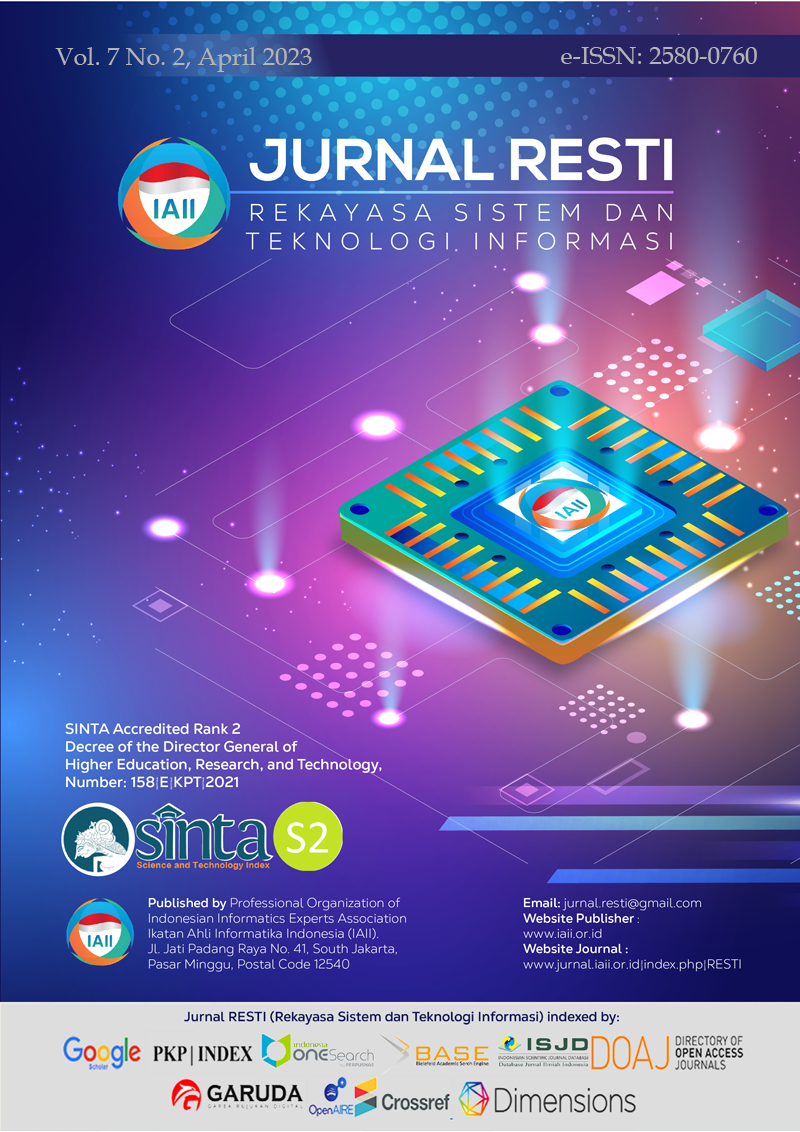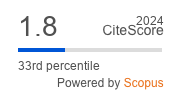Comparison of ARIMA and SARIMA for Forecasting Crude Oil Prices
Abstract
Crude oil price fluctuations affect the business cycle due to affecting the ups and downs of the growth of the economy, which one of the indicators of the economic business cycle phenomenon. The importance of oil price prediction requires a model that can predict future oil prices quickly, easily, and accurately so that it can be used as a reference in determining future policies. Machine learning is an accurate method that can be used in predicting and makes it easier to predict because there is no need to program computers manually. ARIMA is a machine learning algorithm while ARIMA that uses a seasonal component is called SARIMA. Based on background, research purpose is modeling crude oil price forecasting by ARIMA and SARIMA. Forecasting is done on daily crude oil price data taken from Yahoo Finance from January 27, 2020 to January 25, 2023. The evaluation results show the RMSE value of ARIMA and SARIMA is 1.905. The forecast result of 7 days ahead with ARIMA is 86.230003 while SARIMA is 86.260002. The research results are expected to be helpful for policy makers to adopt policies and make the right decisions in the use of crude oil.
Downloads
References
U. Sartika, “Pengaruh inflasi, tingkat suku bunga, kurs, harga minyak dunia dan harga emas dunia terhadap IHSG dan JII di bursa efek Indonesia,” Balance: Jurnal Akuntansi Dan Bisnis, vol. 2, no. 2, pp. 285–294, 2017.
S. Sultan, A. M. Soesilo, S. A. T. Rahayu, L. Hakim, and T. Mulyaningsih, “Siklus Bisnis Perekonomian Indonesia (Studi Empiris Harga Minyak Dan Pertumbuhan Ekonomi Periode 1970-2019),” Buletin Ekonomi: Manajemen, Ekonomi Pembangunan, Akuntansi, vol. 19, no. 2, pp. 87–120, 2022.
B. Agus Setiono, “Fluktuasi Harga Minyak dan Pengaruhnya bagi Ekonomi Indonesia,” 2014.
Y. Nan, R. Sun, and N. Yu, “A study on the correlation between international crude oil price fluctuation cycle measure and economic cycle fluctuation,” Available at SSRN 4003148.
R. Maulid, “Penerapan Contoh Machine Learning dalam Memprediksi Harga Saham,” DQlab. 2021. [Online]. Available: https://dqlab.id/penerapan-contoh-machine-learning-dalam-memprediksi-harga-saham
G. D. Nursyafitri, “4 Contoh Penerapan Machine Learning di Kehidupan Sehari-Hari,” DQlab. 2022. [Online]. Available: dqlab.id/4-contoh-penerapan-machine-learning-di-kehidupan-sehari-hari#:~:text=Machine%20Learning%20ini%20memang%20merupakan,ini%20dinamakan%20dengan%20proses%20training
A. H. Hutasuhut, W. Anggraeni, and R. Tyasnurita, “Pembuatan aplikasi pendukung keputusan untuk peramalan persediaan bahan baku produksi plastik blowing dan inject menggunakan metode ARIMA (Autoregressive Integrated Moving Average) di CV. Asia,” Jurnal Teknik ITS, vol. 3, no. 2, pp. A169–A174, 2014.
D. K. Silalahi, “Forecasting of Poverty Data Using Seasonal ARIMA Modeling in West Java Province,” JTAM (Jurnal Teori dan Aplikasi Matematika), vol. 4, no. 1, pp. 76–86, 2020.
B. W. Taylor and R. S. Russell, “Operations management: creating value along the supply chain,” 2011.
I. M. Wirawan, T. Widiyaningtyas, and M. M. Hasan, “Short term prediction on bitcoin price using ARIMA method,” in 2019 International Seminar on Application for Technology of Information and Communication (iSemantic), 2019, pp. 260–265.
E. Lansiaux, N. Tchagaspanian, and J. Forget, “Community impact on a cryptocurrency: Twitter comparison example between Dogecoin and Litecoin,” Frontiers in Blockchain, vol. 5, p. 829865, 2022.
S. Mohan, A. K. Solanki, H. K. Taluja, A. Singh, and others, “Predicting the impact of the third wave of COVID-19 in India using hybrid statistical machine learning models: A time series forecasting and sentiment analysis approach,” Comput Biol Med, vol. 144, p. 105354, 2022.
B. Agarwal, P. Harjule, L. Chouhan, U. Saraswat, H. Airan, and P. Agarwal, “Prediction of dogecoin price using deep learning and social media trends,” EAI Endorsed Transactions on Industrial Networks and Intelligent Systems, vol. 8, no. 29, pp. e2–e2, 2021.
R. Aroussi, “yfinance: Yahoo! Finance market data downloader,” PyPI. [Online]. Available: https://pypi.org/project/yfinance/
A. A. Adebiyi, O. A. Adewumi, and C. K. Ayo, “Stock price prediction using the ARIMA model,” in International Conference on Computer Modelling and Simulation, 2014.
J. Singh and S. Shyamsundar, “AIOPS Framework For Alerting Performance Issues In Microservices Using Time Series Forecasting”.
T. G Smith, “Pyramid: ARIMA estimators for Python - pyramid 0.9.0 documentation,” Rob J Hyndman. 2017. [Online]. Available: https://alkaline-ml.com/pmdarima/0.9.0/index.html
R. J. Hyndman and G. Athanasopoulos, Forecasting: principles and practice. OTexts, 2018.
W. Y. Rusyida and V. Y. Pratama, “Prediksi harga saham Garuda Indonesia di tengah pandemi COVID-19 menggunakan metode ARIMA,” Square: Journal of Mathematics and Mathematics Education, vol. 2, no. 1, pp. 73–81, 2020.
A. L. Moreno, “Stationary Time Series,” CRAN. [Online]. Available: https://cran.r-project.org/web/packages/TSTutorial/vignettes/Stationary.pdf
L. Sjösten, “A Comparative Study of the KPSS and ADF Tests in terms of Size and Power.” 2022.
D. Fedorová and others, “Selection of unit root test on the basis of length of the time series and value of ar (1) parameter,” Statistika, vol. 96, no. 3, p. 3, 2016.
A. Sudumbrekar, R. Kale, T. Kaurwar, V. Mule, and A. Devkar, “Feasibility Study of ARIMA Model for PM2. 5 Prediction using Real-world Data Gathered from Pune Region”.
S. Oikonomopoulos, “Cryptocurrency Price Prediction using Social Media Sentiment Analysis,” 2022.
D. Ladiray and G. Mazzi, “X11-like seasonal adjustment of daily data,” in 2nd International Conference on Advanced Research Methods and Analytics, 2018.
S. Siami-Namini, N. Tavakoli, and A. S. Namin, “A comparison of ARIMA and LSTM in forecasting time series,” in 2018 17th IEEE international conference on machine learning and applications (ICMLA), 2018, pp. 1394–1401.
F. Wang, Y. Zou, H. Zhang, and H. Shi, “House price prediction approach based on deep learning and ARIMA model,” in 2019 IEEE 7th International Conference on Computer Science and Network Technology (ICCSNT), 2019, pp. 303–307.
T. Baldigara and M. Mamula, “Modelling international tourism demand using seasonal ARIMA models,” Tourism and hospitality management, vol. 21, no. 1, pp. 19–31, 2015.
E. O. Oke et al., “Phenolic compound extraction from Nigerian Azadirachta indica leaves: response surface and neuro-fuzzy modelling performance evaluation with Cuckoo search multi-objective optimization,” Results in Engineering, vol. 8, p. 100160, 2020.
Copyright (c) 2023 Jurnal RESTI (Rekayasa Sistem dan Teknologi Informasi)

This work is licensed under a Creative Commons Attribution 4.0 International License.
Copyright in each article belongs to the author
- The author acknowledges that the RESTI Journal (System Engineering and Information Technology) is the first publisher to publish with a license Creative Commons Attribution 4.0 International License.
- Authors can enter writing separately, arrange the non-exclusive distribution of manuscripts that have been published in this journal into other versions (eg sent to the author's institutional repository, publication in a book, etc.), by acknowledging that the manuscript has been published for the first time in the RESTI (Rekayasa Sistem dan Teknologi Informasi) journal ;








